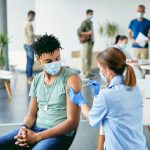New California study shows jab-resistant viruses drive breakthrough COVID infections
 (NaturalHealth365) At this point in the pandemic, we now know that a fully jabbed individual can still catch, spread, and get severely sick with COVID-19 – the so-called breakthrough infection. Additionally, two doses of the COVID-19 shot fail to provide adequate protection in many cases – yet public health officials now insist that millions roll up their sleeves for a booster shot.
(NaturalHealth365) At this point in the pandemic, we now know that a fully jabbed individual can still catch, spread, and get severely sick with COVID-19 – the so-called breakthrough infection. Additionally, two doses of the COVID-19 shot fail to provide adequate protection in many cases – yet public health officials now insist that millions roll up their sleeves for a booster shot.
Just how common are breakthrough infections, anyway? It’s difficult to say, partly because the U.S. Centers for Disease Control and Prevention (CDC) has only been tracking breakthrough cases among hospitalized individuals – not in the general population – since May 2021. But one new study from California reveals some alarming news about the impact of these allegedly “rare” breakthrough cases.
COVID-19 breakthrough cases driving viral variants, new California study shows
The study, based out of the University of California San Francisco (UCSF) and currently available online as a preprint, collected data from 1,373 people from hospital and community settings diagnosed with COVID-19 in the San Francisco area between February and June 2021. 9.1% of the sample (n = 125) were breakthrough COVID-19 infections, meaning they occurred in people who were fully vaxxed.
After analyzing genomic sequences and viral loads, the study authors came to several important conclusions.
First, fully jabbed people were more likely than unjabbed people to be infected by variants of SARS-CoV-2 that had decreased antibody neutralization (antibody neutralization is part of the immune system’s way of preventing viruses from getting into a cell). “These findings suggest that vaccine breakthrough cases are preferentially caused by circulating antibody-resistant SARS-CoV-2 variants,” explain the researchers.
In other words, fully jabbed people were more likely to be infected with antibody-resistant variants, which calls into question how “effective” these shots really are.
Second, vaccinated and unvaccinated people had equal levels of viral loads overall – meaning they had equal amounts of detectable virus in their bodies. This is important because the viral load is one way to measure how likely someone is to infect others; the higher the viral load, the more infectious a person is.
What this suggests is that being jabbed does not reduce the chances that someone will spread COVID-19 if they end up getting infected with SARS-CoV-2 – that is, if the shot doesn’t do what it’s supposed to do and protect a person from getting infected. Of course, the CDC no longer says that the shot is supposed to prevent infection – only that it is supposed to prevent severe illness, hospitalization, and death. Do you see how much they have moved the goalposts?
Third, COVID-19 positive people who show symptoms have higher viral loads compared to COVID-19 positive people without symptoms – and this was true whether they were jabbed or unjabbed. As the researchers put it, “symptomatic breakthrough infections may potentially transmit COVID-19 as efficiently as unvaccinated infections.”
In light of this data, it’s not surprising to hear that nearly a third of all July COVID-19 cases in Los Angeles occurred in people who were fully jabbed.
COVID-19 shots are supposedly “safe and effective” for preventing hospitalization and death, but not for preventing disease spread … so why the push for extra doses and injections in children?
Studies like this one from UCSF suggest that jab-resistant variants of COVID-19 are circulating, and jabbed people can catch and spread these variants, too – possibly more easily than unjabbed folks can. And the blame cannot be placed squarely on unjabbed people, since the COVID-19 shot cannot prevent infection, according to the CDC.
It’s a major logical inconsistency. Fully jabbed people can get COVID-19, and if they do, they can be just as likely to spread COVID-19 as people who don’t get the jab. So, why are fully jabbed people not being fired en masse, as well, nor being subject to weekly testing and public segregation?
Remember: taking the COVID-19 shot means you assume the full risk of the shot itself – and you STILL might get sick anyway. Is this risk-benefit ratio worth it for young, healthy people, including children, who are unlikely to get severely sick and far more likely to die of drowning than die of COVID-19?
Moderna and Johnson & Johnson are seeking authorization for booster shots this month, and Pfizer is seeking Emergency Use Authorization for 5-11-year-old kids. Like you, we are staying tuned.
Sources for this article include:
Medrxiv.org
News-medical.net
CNBC.com
Deadline.com
NBCnews.com
CDC.gov



